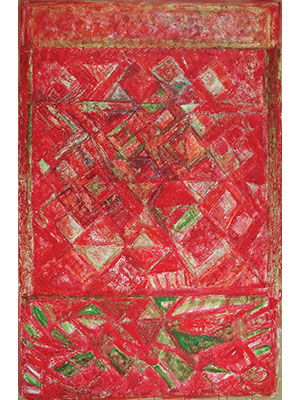
Home and the world: Indian artistes who thrived overseas
Away from their motherland, Indian artists have shaped their own unique destinies
Since the 1940s, Indian artists have lived and worked overseas, some for brief periods—such as Ram Kumar, Akbar Padamsee, Jehangir Sabavala, KK Hebbar and Satish Gujral—and others for the bulk of their career. These stints shaped their practice as well as their patronage. A few like Rabindranath Tagore travelled extensively, using those periods to create works of art during the long journeys. Others such as Nandalal Bose, who accompanied him to a few places, gained from the exposure and his ‘postcards’ from those travels are prized even today. MF Husain, who was peripatetic and frequently exhibited overseas—even considered marriage to a Czechoslovakian in the 1950s following an exhibition and love affair in Prague—died in exile in London in 2011, having stayed away from India since 2006.
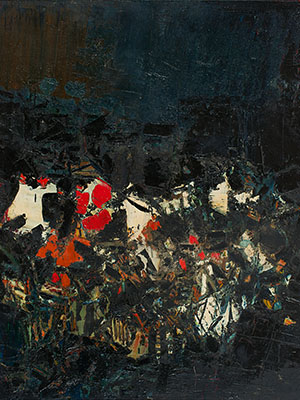
The Tantrist
Zameen
Oil on canvas, 1960
SH Raza (b. 1922)
sh raza’s journey from his native Madhya Pradesh to Mumbai was more difficult than that to Paris where, over six decades, he became an artist of major influence. The first three decades were dedicated to painting landscapes and, later, abstracts, in thick impastos in a style of ‘gestural abstraction’ influenced by American artist Mark Rothko. Having won the coveted critics award early—the first non-European to get it—Raza’s works began to be collected by Europeans who considered him a native artist of France. Having married an artist, Frenchwoman Janine Mongillat, Raza’s style of painting underwent a transformation following a visit to India in 1979 when he began to question the lack of Indianness in his work. He switched from gestural to geometric abstraction, creating a whole vocabulary around his muse, the bindu (point), which—in philosophy and symbology—embraces the whole gamut from the cosmos to nothingness, from the seed or womb to consciousness.
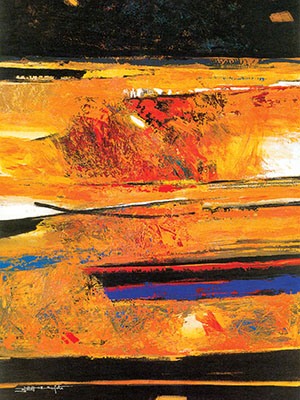
The Colourist
L’autre rive
Acrylic on canvas, 2007
Sujata Bajaj (b. 1958)
sujata bajaj grew up in a household where political leaders and the giants and intellectuals of her parents’s generation walked in freely. Born and educated in Jaipur, spending part of her time in Wardha, she was allowed the freedom to do what she chose, and what that was, above all, was to paint. She studied art in Pune and was then sent off to continue her education in Paris at Ecole Nationale des Beaux-Arts. In Paris, she met and interacted with SH Raza, forging a bond that she holds very special in her life. She also met a Norwegian, Rune Larson, and chose to settle in Paris after her marriage to him. They currently live between Paris and Dubai, and Sujata travels frequently to India on her own work. She is an abstract artist of unusual perspicacity. With the exception of the Ganpati form, with which she has dallied briefly, she has remained focussed on managing space and colour, working in vibrant hues to make her presence and the idea of India felt. Her use of red, in particular, has been unprecedented, making critics remark at her ability to ‘create many reds’. Her works continue to be bought by European collectors.
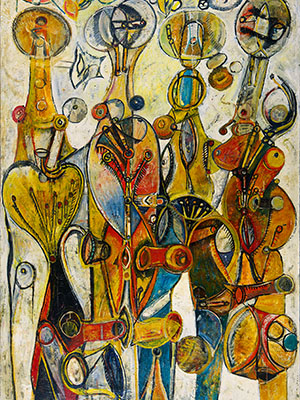
Stars Above, Stars Below
Oil on canvas, 1962
Avinash Chandra (b. 1931, d. 1991)
before arriving in london in 1956, where he settled down to a career in art, Avinash Chandra studied in Delhi, where he also taught art for a while. But the art scene there was not vital enough to engage him, causing him to seek other shores. Swinging London suited his personality. He began with painting expressionist landscapes that were redolent with colour, but gave it up to enter into the hallucinogenic spirit of the time, a non-stop procession of images of women’s breasts and men’s phalluses in an orgiastic procession that came to define his art. Thereafter, Chandra preferred spending his time creating mural-like paintings that appear to have been inspired by Wassily Kandinsky, even though it was Vincent van Gogh and Chaim Soutine who were his muses. The landscapes receded to an elegant line work that epitomised the sexually fraught tension being played out across the continent. In his rendition, genital parts appeared in an abstract manner, both tethered as well as free. He was able to create a sense of order from what was essentially a displacement of form and limb on his canvases.
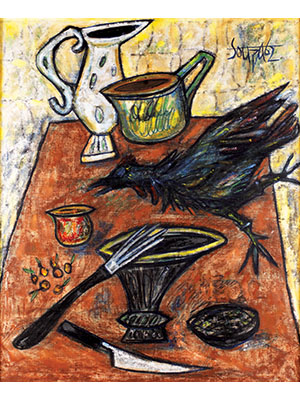
The Rebel
Untitled (Still-Life)
Oil on canvas, 1962
FN Souza (b. 1924, d. 2002)
francis newton souza, born in Portuguese Goa and educated in British India, led the formation of the Progressive Artists’s Group in 1947. At the group’s 1949 exhibition in Mumbai, his nude paintings caused such a scandal that he was literally forced to cover them with a fig leaf. By 1950, he was in London, where he built a successful career, though his paintings of women had started to turn increasingly misogynistic. Cheekily, after Picasso’s death, he termed himself the world’s greatest living artist. Despite his accomplishment, Souza’s life in London was not smooth sailing at all and so, in 1965, he shifted to New York. Here, Souza devised a way to chemically alter the contents of glossy, printed pages over which he began to paint, creating a new medium since described as ‘chemical alterations’.
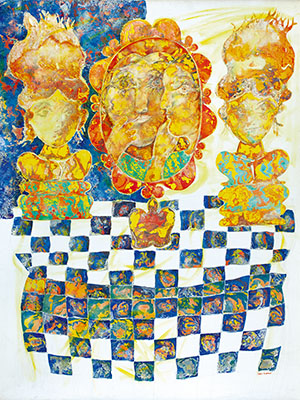
Apres Le Theatre
Acrylic on canvas, 1969
Sakti Burman (b. 1935)
having had an enchanted childhood in what is now Bangladesh and having studied in Kolkata’s Government College of Art & Craft, Sakti Burman took a ship to Paris to study at Ecole Nationale des Beaux-Arts. Surrounded by the works of the masters in its museums, seduced by the city’s charms, and in love with fellow artist Maite Delteil, he settled down in Paris where he still lives for most part of the year, choosing to spend the winter in Delhi. Even though he too experienced the Bengal famine and India’s partition, Saktida—unlike his peers in Calcutta—chose to create happy pictures, electing a magic-realist style of painting that reconciled any differences in history and geography. In his Noah’s Ark—a recurring motif in his paintings—and set within captivating bowers, he brings together figures from Western and Indian mythology and history as well as his family and friends, recreated in the style and patina of aged frescoes, making his work as distinctive as it is appealing.
The Ritualist
Untitled
Oil and acrylic on canvas, 1970
V Viswanadhan (b. 1940)
The lean artist looks like a guru, but make no mistake about his talent. Educated in Chennai, he worked with KCS Paniker who went on to establish the Cholamandal Artists’s Village outside the city in the 1960s. Viswanadhan lived in the artistic commune for a while, and still returns annually, but something about it didn’t click with the artist, and he took off for Paris instead, where he continues to live and work. An abstract painter, Viswanadhan’s striations and lines form grids and patterns that evoke a tantric sensibility, even though the artist himself denies any association with any inherent symbolism in his work. The lines criss-cross to form a hatched pattern that has a sense of vigour and movement that is absent in mere codes of a ritualistic philosophy. The resulting space is both freed and contained within his vocabulary, investing it with a rhythm that beats to an Eastern drum in a Western language.
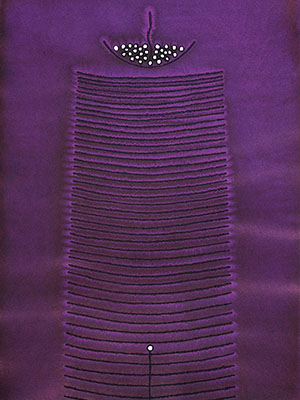
Untitled
Ink and dye on paper, 2006
Sohan Qadri (b. 1932, d. 2011)
Sohan qadri’s childhood, spent in the company of sufis, may have tempered his upbringing, for he spent his youth in search of self-realisation, even confining himself to a monastery in Tibet in search of answers. He travelled extensively before settling down in Copenhagen where he became a leading exponent of yoga, including radical practices such as naked yoga. The maverick artist continued to paint alongside, evolving a technique that was uniquely his own as he combined a wash-and-dye style of painting that, along with the textured lines and holes he created on paper, resulted in works that were unusual and prized. Qadri’s art-making was not independent of his yoga, but probably supplemented it, at least at a philosophical level. It served as a device that would help viewers meditate over the luminescence of the colours and the few lines and dots that formed a pattern. Outwardly, they have little in common with the complex symbols that denote tantra, but in their ability to contain thought and focus, they aid the mind’s ability to concentrate before dissolving into an exploration of consciousness.
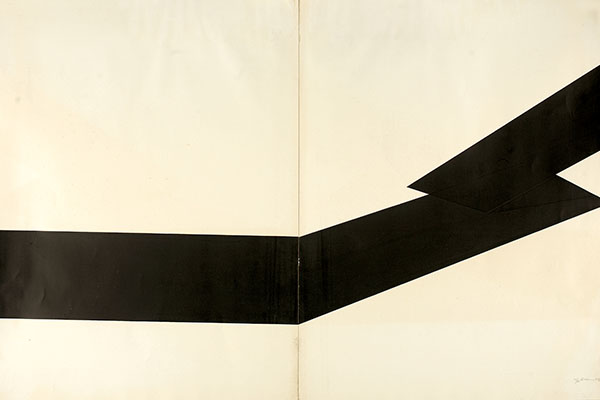
Untitled
Serigraph, 1973
Zarina Hashmi (b. 1937)
A graduate of aligarh muslim university, zarina Hashmi went to Paris’s Atelier 17 for a course in printmaking, and then to Toshi Yoshida Studio in Japan to study woodblock printing. She followed that up with consequent printmaking fellowships in New York (where she has lived since the 1970s), Cornell and Santa Cruz. An itinerant painter, Zarina is a minimalist, using the slightest touch of line to create voids and densities, rendering space as a notion of everything from identity to geography, mapping the lines to suggest home, city or country, confinement and containment, freedom and borders. This quest has as much to do with her search for roots, memory and history, all of which play a part in her search for responses to the idea of self and individuality within a globally emerging world.
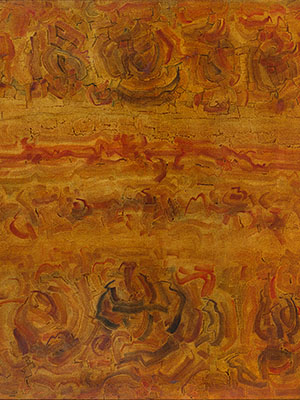
The Recluse
Untitled
Oil on canvas, 1976
Ambadas Khobragade (b. 1922, d. 2012)
Ambadas preferred to let his art do all the talking. Having studied at Sir JJ School of Art in Mumbai, Ambadas travelled to Oslo in 1972. Falling in love with a Norwegian woman, he made this alien, cold country his home for the rest of his life, never to leave it except for rare visits to India. These brief flirtations with the land of his birth fed his soul. In its resonance he found reason to continue painting, his restless brushstrokes recreating images that were nostalgic for him. In their contained momentum, he found a way to communicate what he remembered of the country. There was its immense heat, riot of colours, hot spices, festivals, chaos and camaraderie, all of which he missed acutely, and which he recreated on his canvases, even though it was a sign language which no one understood as well as he did.

The Sculptor
Bow and Arrow
White metal, 1959
SK Bakre (b. 1920, d. 2007)
Sadanand k bakre’s life would be best served by cinema. He was primarily a sculptor and a member of the Progressive Artists’s Group. Early in his career, he made his presence felt in Mumbai, but like many of his peers, he made London his home. Life in London was not easy, but Bakre remained exacting in his standards. He married a German nurse there, and the two could be seen hawking his artworks from a wheelbarrow in Hyde Park. He was noticed and written about. His sculptures combined modernist elements with a narrative idea and were infused with concepts that seemed far larger than the size he worked in. He also painted, and his paintings too were imbued with a sculptural quality. To support his career, Bakre worked as a jeweller’s assistant, in a mortuary, as gardener and mason. His travels to America resulted in more paintings than sculpture. Towards the end of his life, he chose to return to India for reasons that were personally humiliating—his wife had eloped with his brother. That ignominy drove him to settle in a mofussil town away from the limelight he had earlier craved, where he died almost neglected.
(This story appears in the Mar-Apr 2015 issue of ForbesLife India. To visit our Archives, click here.)
